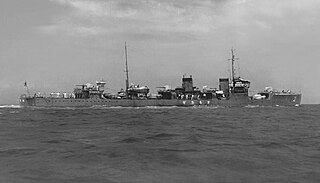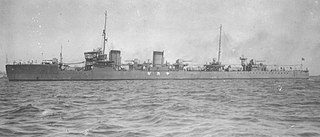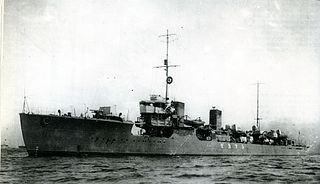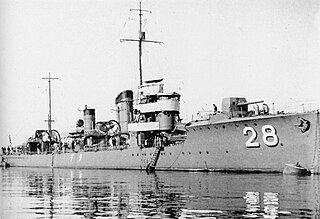
The Japanese destroyer Hayate was one of nine Kamikaze-class destroyers built for the Imperial Japanese Navy (IJN). During the Pacific War, she was sunk by American coast-defense guns during the Battle of Wake Island in December 1941, the first Japanese warship to be lost during the war. Only a single man of her crew was rescued.

The Japanese destroyer Minekaze was the lead ship of the Minekaze-class destroyers, built for the Imperial Japanese Navy (IJN) during the late 1910s. The ship served in the Second Sino-Japanese War during the 1930s and spent the Pacific War on escort duties in Japanese waters and the East China Sea. She was sunk by an American submarine in early 1944 near Formosa.

The Japanese destroyer Sawakaze was one of 15 Minekaze-class destroyers built for the Imperial Japanese Navy (IJN) during the late 1910s. The ship served as a plane guard and played a minor role in the Second Sino-Japanese War during the 1930s. She spent most of the Pacific War on escort duties in Japanese waters before she became an anti-submarine training ship in 1944. Sawakaze survived the war and was broken up for scrap in 1948.

The Japanese destroyer Okikaze was one of 15 Minekaze-class destroyers built for the Imperial Japanese Navy during the late 1910s. The ship served as a plane guard and played a minor role in the First Shanghai incident during the 1930s. She spent most of the Pacific War on escort duties in Japanese waters until she was sunk by an American submarine in early 1943.

The Japanese destroyer Hakaze was one of 15 Minekaze-class destroyers built for the Imperial Japanese Navy (IJN) in the late 1910s. During the Pacific War, she supported Japanese operations during the Malayan, Dutch East Indies, and Guadalcanal Campaigns. The ship was sunk by an American submarine in early 1943.

The Japanese destroyer Yakaze was one of 15 Minekaze-class destroyers built for the Imperial Japanese Navy (IJN) during the late 1910s. A decade later, the ship served as a plane guard. During the Pacific War, she was initially as the mother ship for a remotely controlled target ship and then became a radio-controlled target ship herself in 1942. Although she was badly damaged in mid-1945, Yakaze survived the war and was scrapped in 1948.

The Japanese destroyer Shimakaze was one of 15 Minekaze-class destroyers built for the Imperial Japanese Navy (IJN) in the late 1910s. The ship was converted into a patrol boat in 1940 and then into a destroyer transport the next year. After the start of the Pacific War, she participated in the Philippines Campaign in late 1941, the Dutch East Indies campaign in early 1942 and played a minor role in the Battle of Midway in mid-1942 before she was sunk by an American submarine in early 1943.

The Japanese destroyer Mikazuki was one of twelve Mutsuki-class destroyers, built for the Imperial Japanese Navy (IJN) during the 1920s. At the beginning of the Pacific War, she served in home waters as the plane guard for those aircraft carriers that were training or working up. In mid-1942, the ship played a minor role in the Battle of Midway and was then assigned to convoy escort duties between Formosa and Japan for the next year. Mikazuki was then transferred to the Solomon Islands in mid-1943 and was destroyed by American bombers after running aground.

The Japanese destroyerKamikaze was the lead ship of nine Kamikaze-class destroyers built for the Imperial Japanese Navy (IJN) during the 1920s. At the beginning of the Pacific War in December 1941, the ship was assigned to the Ōminato Guard District. She remained in northern Japanese waters until mid-1942 when she participated in the Aleutian Islands Campaign. Kamikaze continued to patrol northern Japanese waters until early 1945 when she was transferred to the Singapore area.

The Japanese destroyer Oite was one of nine Kamikaze-class destroyers built for the Imperial Japanese Navy during the 1920s.During the Pacific War, she participated in the Battle of Wake Island in December 1941 and the occupations of New Guinea and the Solomon Islands in early 1942.

The Japanese destroyer Kiku (菊) was one of 21 Momi-class destroyers built for the Imperial Japanese Navy (IJN) in the late 1910s. She was converted into a patrol boat in 1940 and spent the Pacific War on escort duties, mostly in Japanese waters. The ship was sunk by American carrier aircraft in early 1944.

The Japanese destroyer Aoi (葵) was one of 21 Momi-class destroyers built for the Imperial Japanese Navy (IJN) in the late 1910s. She was converted into a patrol boat in 1940 and was lost during the Battle of Wake Island shortly after the beginning of the Pacific War in December 1941.

The Japanese destroyer Susuki (薄) was one of 21 Momi-class destroyers built for the Imperial Japanese Navy (IJN) in the late 1910s. In 1940, she was converted into a No.31-class patrol boat and renamed Patrol Boat No.34. She was sunk by American aircraft in July 1944.

The Japanese destroyer Tsuta (蔦) was one of 21 Momi-class destroyers built for the Imperial Japanese Navy (IJN) in the late 1910s. In 1940, she was converted into a No.31-class patrol boat and renamed Patrol Boat No. 35. She was sunk by American aircraft in September 1942.

The Japanese destroyer Hagi (萩) was one of 21 Momi-class destroyers built for the Imperial Japanese Navy (IJN) in the late 1910s. She was converted into a patrol boat in 1940 and was lost during the Battle of Wake Island shortly after the beginning of the Pacific War in December 1941.

The Japanese destroyer Fuji (藤) was one of 21 Momi-class destroyers built for the Imperial Japanese Navy (IJN) in the late 1910s. She was converted into a patrol boat in 1940 and was surrendered to the Netherlands in July 1946 at Surabaya; she was finally scrapped on August 10, 1946.

The Japanese destroyer Hishi (菱) was one of 21 Momi-class destroyers built for the Imperial Japanese Navy (IJN) in the late 1910s. She was converted into a patrol boat in 1940 and spent the Pacific War on escort duties, mostly in Japanese waters. The ship was sunk off Borneo by USS Pope on 24 January 1942 and was struck from the naval list on 10 April 1942.

The Japanese destroyer Tade (蓼) was one of 21 Momi-class destroyers built for the Imperial Japanese Navy (IJN) in the late 1910s. She was converted into a patrol boat in 1940 and was sunk south of Yonaguni at 23.45°N 122.45°E by the United States Navy submarine USS Seawolf on 23 April 1943.

The Japanese destroyer Hasu (蓮) was one of 21 Momi-class destroyers built for the Imperial Japanese Navy (IJN) in the late 1910s. After serving for 23 years and throughout the Pacific War, she was retired 12 October 1945 and scuttled as breakwater in Fukui in 1946.

The Japanese destroyer Yomogi (薄) was one of 21 Momi-class destroyers built for the Imperial Japanese Navy (IJN) in the late 1910s. In 1940, she was converted to Patrol Boat No. 38. The ship was torpedoed in the Bashi Strait by USS Atule on November 25, 1944, and stricken from the navy list on March 10, 1945.














